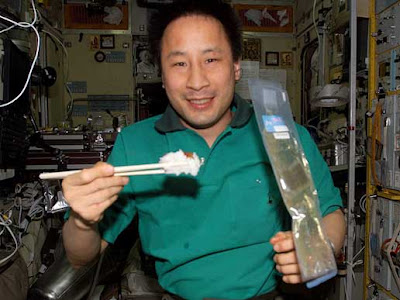Picking up from yesterday: the story of Food In Space is an utterly fascinating one! The guiding principle seems to be:
It's not enough to count calories and add vitamins, then assume humans will eat anything set in front of them, even in a hostile, foreign environment. When not naturally stirred by olfactory and flavorsome stimulus, the body can resign itself to avoiding food entirely... leading to physiological and psychological problems.
Some cliff notes:
- "Space Food Tools" include vacuum moisture analyzers, colorimeters, texture testers, viscometers and (one wonders whose job it is to keep track of this) a shelf-life test chamber.
- Why freeze-drying? It deprives bacteria of the water they need to multiply. Safety reigns supreme, hence the shrink-wrap and airtight cans to prevent oxidation. Keeping food from spoiling and ensuring it retain vitamins through storage processes is of paramount concern.
- Why Tang? Powdered drinks are lighter, and take less space… but NASA did not invent Tang, that was General Mills! Gemini astronauts merely added to the water that was a by-product of their life-support system. That's all there was to drink, and it improved the metallic taste. However, Tang didn't last to the Apollo era.

First American food in space
My favorite story comes from 1968... when one the food designers was forced to eat his own creations and didn't much care for it! Apollo astronauts only stood to gain, however, and the result was the first major leap in space-food science, followed by years of experimentation.
In micro-gravity, astronauts experience congestion, as there is no force pulling bodily fluids down into their legs. Everything pools in the head! Even after initial adaptation to weightlessness, this has the effect of making food taste bland. Smells do not travel well in space, and this lack of sensation also dulls the taste buds.
Thus, richly flavorful items like shrimp with tangy sauce, or jambalaya with spicy garlic beans (special recipes developed by Emeril Lagasse) are preferred the longer astronauts are in orbit.

Americans aboard Mir weren't crazy about borscht or jellied perch, and Russians were equally un-thrilled with bricks of mac & cheese. But it never hurts to try what is brought aboard by various nations as we expand our cultural knowledge… and hey, the first sushi was just rolled in space! I'm sure international crews will continue to experiment with ingredients and preparations.
In my opinion, one of the best descriptions of meal creation in low gravity came from astronaut Sandra Magnus on Expedition 18. It may surprise you what kinds of ingredients make up into orbit these days.
I read this, thinking, "Wow, I barely take time to microwave Lean Cuisine packages. Can you imagine performing such complex preparations for months on end?" I would definitely starve in space, LOL…
For those who are curious or interested in the history of how we got to where we are with nutrition in space, see my separate essay, Space Food In a Nutshell. It's a far more complex (and amusing) story than most people realize!


































































